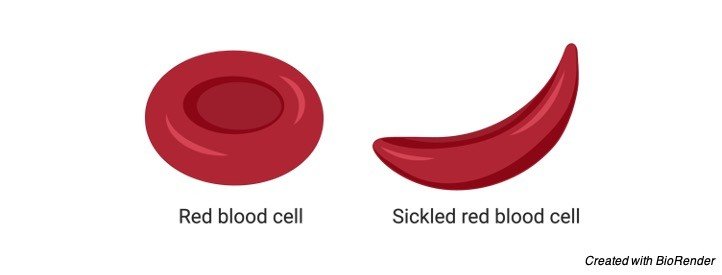What is Sickle Cell Anemia
We come across many disorders in our day-to-day life, some are acquired and some are transmitted through genes from our ancestors, which is known as genetic disorder.
Sickle cell anemia is one such inherited disease which is caused through genetic disorder or through mutations occurring due to environmental factors, which leads to a defect in a DNA molecule.

Cause of Sickle Cell Anemia
It is one of the abnormal inherited disorder caused by mutation in an autosomal gene.
Here the red blood cells of an affected individual is of sickle shaped instead of having a biconcave shape. Where these sickle shaped blood cells do not provide a capacity to carry enough oxygen and nutrients all over the body which results in anemia as well as other diseases.
The people with this type of red blood cells are called as sickle cell traits.
The sickle shaped cells cannot pass through the blood vessels easily as they gets struck in between the small blood vessels such as capillaries which results in haemolytic anemia and leads to death of an individual.
This is caused due to the mutation in the single-base, the sixth amino acid in the chain is valine, rather than glutamic acid
Characteristics of Sickle Cell Anemia
Linus Pauling was the first one to identify this type of mutation in an individual where the genotype for this mutation is Hbs1 Hbs1which is a condition that our body does not have enough haemoglobin, because Hbs1 have negative charge compared to that of HbA1.
If the individual is a carrier of this syndrome, they have their genotype as HbA1 Hbs1 which leads to a condition of mild sickle shaped anemia.
This is considered by Pauling as one of the gene molecular disease.
Effects of Sickle Cell Anemia
The sickle cell anemia leads to the increased fragility of the red blood cell which leads to haemolytic anemia and it also increases the viscosity of the blood and it also lets the blood cells to stag in the small blood vessels which forms a thrombus and infracts.
This phenomenon also causes damage to the spleen which is often said to be autopsleenectomy where the spleen ends as a non-functional unit and it also leads to other side effects such as pneumococcal meningitis and other infectious diseases.
Sickle Cell Anemia Epidemiology
The Sickle cell anemia is most common in central Africa where almost 20 percent of the people are having this trait and are affected with this disease.
About 2% of these die in an early stage of their life.
It has also been distributed widely in USA where this trait Hbs has found in Arab racial groups and it is also rarely seen among India and American Negros.
How Sickle Cell Anemia Affects?
The people who are having sickle cell trait as Sis/Sis are affected by this disease but they don’t show symptoms in certain cases.
But in some cases, in high altitudes, it affects the respiratory tract and bleeding in the renal papillae.
The persons who are having homozygous trait of sickle cell anemia do not get infected by malaria. But they die at the early stages of life.
The normal trait persons are not resistant to malaria. The persons who have the heterozygous condition of causing sickle cell anemia is also resistant to malarial infections and they lead almost a normal life style and anemia is not severe in such cases.
Types of Sickle Cell Anemia
There are many types of sickle cell anemia depending upon the various changes in the traits.
Some of the types are discussed as follows;
HbSS: In this case the person gets two inherited genes from each of their parents This type is most severe.
HBSC: Here the defected gene is inherited from a single parent and a normal gene from the other parent it also results in abnormal haemoglobin and results in a carrier offspring but it does not cause any serious symptoms.
HbS- Beta thalassemia: A individual suffering from this disorder get one of allele from an infected sickle cell parent and the other from the Beta thalassemia affected person.
Symptoms of Sickle Cell Anemia
In general, if our body does not get any enough oxygen it causes many complications and symptoms as the outcome of an infection.
These symptoms vary according to the age and life style factors of the individual. It causes early symptoms such as fatigue, jaundice; which leads to yellowing of the skin and eyes, swelling of hands and feet; which causes severe pain.
Later the symptoms are little complicated such as acute chest syndrome, damage in a normal vision, enlarging of spleen, ulcers in the leg, Heart attack, stroke, deep thrombosis in the veins, infections in the heart, kidney or liver.
Formation of gallstones, infertility in males and causes of malnutrition in kids, high blood pressure in the lungs which is also known as Pulmonary hypertension, bone and joint inflammation etc.
Treatment of Sickle Cell Anemia
Currently the sickle anemia has no cure but it is possible to overcome the difficulty of this syndrome through blood transfusions or through stem cell transplants the disease can be controlled.
Sickle Cell Anemia Citations
Share









